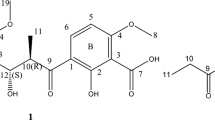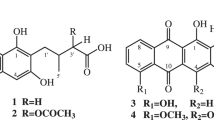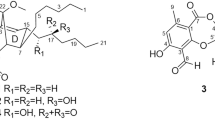Abstract
Two new 1,4,6-trihydroxy-8-alkylated-9,10-anthraquinones (1–2) were isolated from the culture broth of the soil actinomycete Streptomyces sp. WS-13394. Their structures were elucidated on the basis of extensive spectroscopic analysis, including mass spectrometry (MS), nuclear magnetic resonance (NMR), and electronic circular dichroism (ECD). Compounds 1 and 2, together with eight analogs (3–10), were evaluated for their antibacterial activities against five pathogens. The tested derivatives of alkylated anthraquinone exhibited selective activities to Gram-positive bacteria, while compounds 1 and 5 showed obvious activities against two zoonotic pathogens, Erysipelothrix rhusiopathiae and Streptococcus suis, with MIC values ranging from 3.13 to 12.5 µg ml−1.
This is a preview of subscription content, access via your institution
Access options
Subscribe to this journal
Receive 12 print issues and online access
$259.00 per year
only $21.58 per issue
Buy this article
- Purchase on Springer Link
- Instant access to full article PDF
Prices may be subject to local taxes which are calculated during checkout




Similar content being viewed by others
References
Semwal RB, Semwal DK, Combrinck S, Viljoen A. Emodin—a natural anthraquinone derivative with diverse pharmacological activities. Phytochemistry. 2021;190:112854.
Singh J, Hussain Y, Luqman S, Meena A. Purpurin: a natural anthraquinone with multifaceted pharmacological activities. Phytother Res. 2020;35:2418–28.
Prateeksha, Yusuf MA, Singh BN, Sudheer S, Kharwar RN, Siddiqui S, et al. Chrysophanol: a natural anthraquinone with multifaceted biotherapeutic potential. Biomolecules. 2019;9:68.
Lu H, Wang CC, Lu WJ, Li XD, Wu ZY, Wang GY, et al. Apigenin and ampicillin as combined strategy to treat severe Streptococcus suis infection. Molecules. 2021;26:1980.
Brooke CJ, Riley TV. Erysipelothrix rhusiopathiae: bacteriology, epidemiology and clinical manifestations of an occupational pathogen. J Med Microbiol. 1999;48:789–99.
Wu ZY, Zhang YN, Fang W, Shi LQ, Wan ZY. Four new anthraquinone analogues from a soil actinomycete Streptomyces sp. WS-13394 and their bioactivities. Nat Prod Res. 2018;32:412–7.
Wu ZY, Fang W, Shi LQ, Wan ZY, Min Y, Wang KM. New cytotoxic alkylated anthraquinone analogues from a soil actinomycete Streptomyces sp. WS-13394. Chem Pharm Bull. 2014;62:118–21.
Luo XW, Lin XP, Tao HM, Wang JF, Li JF, Yang B, et al. Isochromophilones A-F, cytotoxic chloroazaphilones from the marine mangrove endophytic fungus Diaporthe sp. SCSIO 41011. J Nat Prod. 2018;81:934–41.
Frisch MJ, Trucks GW, Schlegel HB, Scuseria GE, Robb MA, Cheeseman JR, et al. Gaussian 09, Revision D.01. Wallingford, CT: Gaussian Inc; 2013.
Liang Z, Gu TW, Wang JJ, She JL, Ye YX, Cao YX, et al. Chromene and chromone derivatives as liver X receptors modulators from a marine-derived Pestalotiopsis neglecta fungus. Bioorg Chem. 2021;112:104927.
Wi YM, Greenwood-Quaintance KE, Schuetz AN, Ko KS, Peck KR, Song JH, et al. Activity of ceftolozane-tazobactam against carbapenem-resistant, non-carbapenemase-producing Pseudomonas aeruginosa and associated resistance mechanisms. Antimicrob Agents Chemother. 2017;62:e01970–17.
Lu H, Lu WJ, Zhu YW, Wang CC, Shi LM, Li XD, et al. Auranofin has advantages over first-line drugs in the treatment of severe Streptococcus suis infections. Antibiotics. 2020;10:26.
Acknowledgements
This research was financially supported by Natural Science Foundation of Hubei Province, China (2021CFB070) and Hubei Agricultural Science and Technology Innovation Center (2019-620-000-001-027).
Author information
Authors and Affiliations
Corresponding author
Ethics declarations
Conflict of interest
The authors declare no competing interests.
Additional information
Publisher’s note Springer Nature remains neutral with regard to jurisdictional claims in published maps and institutional affiliations.
Supplementary information
Rights and permissions
About this article
Cite this article
Wu, Z., Liu, M., Li, K. et al. 1,4,6-trihydroxy-8-alkylated-9,10-anthraquinones with antibacterial activities from soil-derived Streptomyces sp. WS-13394. J Antibiot 75, 375–379 (2022). https://doi.org/10.1038/s41429-022-00533-7
Received:
Revised:
Accepted:
Published:
Issue Date:
DOI: https://doi.org/10.1038/s41429-022-00533-7



